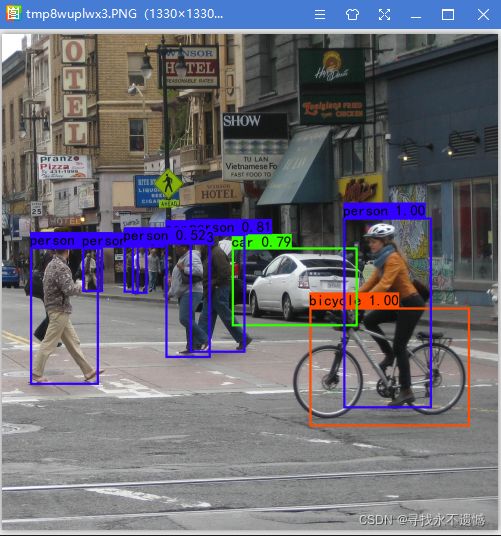【YOLOv3 预测】YOLOv3图像输入->处理->输出全过程
文章目录
- 1 数据输入输出代码详解
- 2 yolo.detect_image详解
- 3 感谢链接
1 数据输入输出代码详解
数据输入方式主要包括三种:
- 读取本地一张图片(代码中
predict状态) - 读取本地文件夹中所有图片(代码中
dir_predict状态) - 视频输入状态(代码中
video状态),视频输入又分为摄像头输入和本地视频输入两种,当video_path=0时表示检测摄像头。
将这三种输入方式归总到一个predict.py文件中,从全局角度看图像输入、处理、输出的全过程,其代码如下:
# -----------------------------------------------------------------------#
# predict.py将单张图片预测、摄像头检测和目录遍历检测等功能
# 整合到了一个py文件中,通过指定mode进行模式的修改。
# -----------------------------------------------------------------------#
import time
import cv2
import numpy as np
from PIL import Image
from yolo import YOLO # 从yolo.py文件中导入YOLO类,详见下一小节
if __name__ == "__main__":
yolo = YOLO() # 在这儿进行类的实例化,详见下一小节
# ----------------------------------------------------------------------------------------------------------#
# mode用于指定测试的模式:
# 'predict'表示单张图片预测,如果想对预测过程进行修改,如保存图片,截取对象等,可以先看下方详细的注释
# 'video'表示视频检测,可调用摄像头或者视频进行检测,详情查看下方注释。
# 'dir_predict'表示遍历文件夹进行检测并保存。默认遍历img文件夹,保存img_out文件夹,详情查看下方注释。
# ----------------------------------------------------------------------------------------------------------#
mode = "predict"
# ----------------------------------------------------------------------------------------------------------#
# video_path用于指定视频的路径,当video_path=0时表示检测摄像头
# 想要检测视频,则设置如video_path = "xxx.mp4"即可,代表读取出根目录下的xxx.mp4文件。
# video_save_path表示视频保存的路径,当video_save_path=""时表示不保存
# 想要保存视频,则设置如video_save_path = "yyy.mp4"即可,代表保存为根目录下的yyy.mp4文件。
# video_fps用于保存的视频的fps
# video_path、video_save_path和video_fps仅在mode='video'时有效
# 保存视频时需要ctrl+c退出或者运行到最后一帧才会完成完整的保存步骤。
# ----------------------------------------------------------------------------------------------------------#
video_path = 0 # video_path用于指定视频的路径,当video_path=0时表示检测摄像头
video_save_path = ""
video_fps = 25.0
# -------------------------------------------------------------------------#
# test_interval用于指定测量fps的时候,图片检测的次数
# 理论上test_interval越大,fps越准确。
# -------------------------------------------------------------------------#
test_interval = 100
# -------------------------------------------------------------------------#
# dir_origin_path指定了用于检测的图片的文件夹路径
# dir_save_path指定了检测完图片的保存路径
# dir_origin_path和dir_save_path仅在mode='dir_predict'时有效
# -------------------------------------------------------------------------#
dir_origin_path = "img/"
dir_save_path = "img_out/"
if mode == "predict":
'''
1、如果想要进行检测完的图片的保存,利用r_image.save("img.jpg")即可保存,直接在predict.py里进行修改即可。
2、如果想要获得预测框的坐标,可以进入yolo.detect_image函数,在绘图部分读取top,left,bottom,right这四个值。
3、如果想要利用预测框截取下目标,可以进入yolo.detect_image函数,在绘图部分利用获取到的top,left,bottom,right这四个值
在原图上利用矩阵的方式进行截取。
4、如果想要在预测图上写额外的字,比如检测到的特定目标的数量,可以进入yolo.detect_image函数,在绘图部分对predicted_class进行判断,
比如判断if predicted_class == 'car': 即可判断当前目标是否为车,然后记录数量即可。利用draw.text即可写字。
'''
while True:
img = input('Input image filename:')
try:
image = Image.open(img)
except:
print('Open Error! Try again!')
continue
else:
r_image = yolo.detect_image(image)
r_image.show()
elif mode == "video":
capture = cv2.VideoCapture(video_path) # video_path用于指定视频的路径,当video_path=0时表示检测摄像头
if video_save_path != "":
fourcc = cv2.VideoWriter_fourcc(*'XVID')
size = (int(capture.get(cv2.CAP_PROP_FRAME_WIDTH)), int(capture.get(cv2.CAP_PROP_FRAME_HEIGHT)))
out = cv2.VideoWriter(video_save_path, fourcc, video_fps, size)
ref, frame = capture.read()
if not ref:
raise ValueError("未能正确读取摄像头(视频),请注意是否正确安装摄像头(是否正确填写视频路径)。")
fps = 0.0
while (True):
t1 = time.time()
# 读取某一帧
ref, frame = capture.read()
if not ref:
break
# 格式转变,BGRtoRGB
frame = cv2.cvtColor(frame, cv2.COLOR_BGR2RGB)
# 转变成Image
frame = Image.fromarray(np.uint8(frame))
# 进行检测
frame = np.array(yolo.detect_image(frame))
# RGBtoBGR满足opencv显示格式
frame = cv2.cvtColor(frame, cv2.COLOR_RGB2BGR)
fps = (fps + (1. / (time.time() - t1))) / 2
print("fps= %.2f" % (fps))
frame = cv2.putText(frame, "fps= %.2f" % (fps), (0, 40), cv2.FONT_HERSHEY_SIMPLEX, 1, (0, 255, 0), 2)
cv2.imshow("video", frame)
c = cv2.waitKey(1) & 0xff
if video_save_path != "":
out.write(frame)
if c == 27:
capture.release()
break
print("Video Detection Done!")
capture.release()
if video_save_path != "":
print("Save processed video to the path :" + video_save_path)
out.release()
cv2.destroyAllWindows()
elif mode == "dir_predict":
import os
from tqdm import tqdm
img_names = os.listdir(dir_origin_path)
for img_name in tqdm(img_names): # tqdm用来在长循环中添加一个进度提示信息
if img_name.lower().endswith(
('.bmp', '.dib', '.png', '.jpg', '.jpeg', '.pbm', '.pgm', '.ppm', '.tif', '.tiff')):
image_path = os.path.join(dir_origin_path, img_name)
image = Image.open(image_path)
r_image = yolo.detect_image(image)
if not os.path.exists(dir_save_path):
os.makedirs(dir_save_path)
r_image.save(os.path.join(dir_save_path, img_name))
else:
raise AssertionError("Please specify the correct mode: 'predict', 'video', or 'dir_predict'.")
2 yolo.detect_image详解
包括模型初始化、模型推理得到预测结果,解码,非极大值抑制(确实是在解码后面),将结果可视化。
代码中包含各部分介绍及重要函数的参考链接。
import colorsys # 用来给画框设置不同的颜色
import numpy as np
import torch
import torch.nn as nn
from PIL import ImageDraw, ImageFont
# yolov3网络结构,详解见参考链接https://blog.csdn.net/weixin_45377629/article/details/124080087
from nets.yolo import YoloBody
#---------------------------------------------------------#
# cvtColor将图像转换成RGB图像,防止灰度图在预测时报错。
# 代码仅支持RGB图像的预测,所有其它类型的图像都会转化成RGB
# get_anchors获得先验框
# get_classes获得类别
# preprocess_input归一化
# resize_image对输入图像进行resize
#---------------------------------------------------------#
from utils.utils import (cvtColor, get_anchors, get_classes, preprocess_input, resize_image)
# 对网络预测结构进行解码,详解见参考链接https://blog.csdn.net/weixin_45377629/article/details/124144913
from utils.utils_bbox import DecodeBox
class YOLO(object):
_defaults = {
# --------------------------------------------------------------------------#
# 使用自己训练好的模型进行预测一定要修改model_path和classes_path!
# model_path指向logs文件夹下的权值文件,classes_path指向model_data下的txt
#
# 训练好后logs文件夹下存在多个权值文件,选择验证集损失较低的即可。
# 验证集损失较低不代表mAP较高,仅代表该权值在验证集上泛化性能较好。
# 如果出现shape不匹配,同时要注意训练时的model_path和classes_path参数的修改
# --------------------------------------------------------------------------#
"model_path": 'model_data/yolo_weights.pth',
"classes_path": 'model_data/coco_classes.txt',
# ---------------------------------------------------------------------#
# anchors_path代表先验框对应的txt文件,一般不修改。
# anchors_mask用于帮助代码找到对应的先验框,一般不修改。
# ---------------------------------------------------------------------#
"anchors_path": 'model_data/yolo_anchors.txt',
"anchors_mask": [[6, 7, 8], [3, 4, 5], [0, 1, 2]],
# ---------------------------------------------------------------------#
# 输入图片的大小,必须为32的倍数。
# ---------------------------------------------------------------------#
"input_shape": [416, 416],
# ---------------------------------------------------------------------#
# 只有得分大于置信度的预测框会被保留下来
# ---------------------------------------------------------------------#
"confidence": 0.5,
# ---------------------------------------------------------------------#
# 非极大抑制所用到的nms_iou大小
# ---------------------------------------------------------------------#
"nms_iou": 0.3,
# ---------------------------------------------------------------------#
# 该变量用于控制是否使用letterbox_image对输入图像进行不失真的resize,
# 在多次测试后,发现关闭letterbox_image直接resize的效果更好
# ---------------------------------------------------------------------#
"letterbox_image": False,
# -------------------------------#
# 是否使用Cuda
# 没有GPU可以设置成False
# -------------------------------#
"cuda": True,
}
# ---------------------------------------------------#
# 初始化YOLO
# ---------------------------------------------------#
def __init__(self, **kwargs):
self.__dict__.update(self._defaults)
for name, value in kwargs.items():
setattr(self, name, value)
# ---------------------------------------------------#
# 获得种类和先验框的数量
# DecodeBox详解见:https://blog.csdn.net/weixin_45377629/article/details/124144913
# ---------------------------------------------------#
self.class_names, self.num_classes = get_classes(self.classes_path)
self.anchors, self.num_anchors = get_anchors(self.anchors_path)
self.bbox_util = DecodeBox(self.anchors, self.num_classes, (self.input_shape[0], self.input_shape[1]),
self.anchors_mask)
# ---------------------------------------------------#
# 画框设置不同的颜色
# ---------------------------------------------------#
hsv_tuples = [(x / self.num_classes, 1., 1.) for x in range(self.num_classes)]
self.colors = list(map(lambda x: colorsys.hsv_to_rgb(*x), hsv_tuples))
self.colors = list(map(lambda x: (int(x[0] * 255), int(x[1] * 255), int(x[2] * 255)), self.colors))
self.generate() # 生成 yolov3 模型并加载权重
# ---------------------------------------------------#
# 生成模型,模型初始化,放到device上,加载模型参数,改成eval()模式
# ---------------------------------------------------#
def generate(self):
# ---------------------------------------------------#
# 建立yolov3模型,载入yolov3模型的权重
# ---------------------------------------------------#
self.net = YoloBody(self.anchors_mask, self.num_classes)
device = torch.device('cuda' if torch.cuda.is_available() else 'cpu')
self.net.load_state_dict(torch.load(self.model_path, map_location=device))
self.net = self.net.eval()
print('{} model, anchors, and classes loaded.'.format(self.model_path))
if self.cuda:
self.net = nn.DataParallel(self.net)
self.net = self.net.cuda()
# ---------------------------------------------------#
# 检测图片
# ---------------------------------------------------#
def detect_image(self, image):
image_shape = np.array(np.shape(image)[0:2])
# ---------------------------------------------------------#
# 在这里将图像转换成RGB图像,防止灰度图在预测时报错。
# 代码仅仅支持RGB图像的预测,所有其它类型的图像都会转化成RGB
# ---------------------------------------------------------#
image = cvtColor(image)
# ---------------------------------------------------------#
# 给图像增加灰条,实现不失真的resize
# 也可以直接resize进行识别
# ---------------------------------------------------------#
image_data = resize_image(image, (self.input_shape[1], self.input_shape[0]), self.letterbox_image)
# ---------------------------------------------------------#
# 添加上batch_size维度,缺少这个维度,网络没法预测,preprocess_input表示数据归一化 image /= 255.0
# ---------------------------------------------------------#
image_data = np.expand_dims(np.transpose(preprocess_input(np.array(image_data, dtype='float32')), (2, 0, 1)), 0)
with torch.no_grad():
images = torch.from_numpy(image_data) # 从numpy形式转成torch需要的形式
if self.cuda:
images = images.cuda()
# ---------------------------------------------------------#
# 将图像输入网络当中进行预测!
# 然后进行解码,可参考链接https://blog.csdn.net/weixin_45377629/article/details/124144913
# ---------------------------------------------------------#
outputs = self.net(images)
outputs = self.bbox_util.decode_box(outputs)
# ---------------------------------------------------------#
# 将预测框进行堆叠,然后进行非极大抑制 功能:筛选出一定区域内,属于同一种类得分最大的方框
# 此处可参考链接:https://blog.csdn.net/weixin_45377629/article/details/124202975
# ---------------------------------------------------------#
results = self.bbox_util.non_max_suppression(torch.cat(outputs, 1), self.num_classes, self.input_shape,
image_shape, self.letterbox_image, conf_thres=self.confidence,
nms_thres=self.nms_iou)
if results[0] is None:
return image
top_label = np.array(results[0][:, 6], dtype='int32') # 预测框的种类
top_conf = results[0][:, 4] * results[0][:, 5] # 预测框的置信度
top_boxes = results[0][:, :4] # 预测框的坐标
# ------------------------------#
# 打印每个类别的数量
# ------------------------------#
print("top_label:", top_label)
classes_num = np.zeros([self.num_classes])
for i in range(self.num_classes):
num = np.sum(top_label == i):
if num > 0:
print(self.class_names[i], " : ", num)
classes_num[i] = num
print("classes_num: ", classes_num)
# ---------------------------------------------------------#
# 设置字体与边框厚度
# ---------------------------------------------------------#
font = ImageFont.truetype(font='model_data/simhei.ttf',
size=np.floor(3e-2 * image.size[1] + 0.5).astype('int32'))
thickness = int(max((image.size[0] + image.size[1]) // np.mean(self.input_shape), 1))
# ---------------------------------------------------------#
# 图像绘制
# ---------------------------------------------------------#
for i, c in list(enumerate(top_label)):
predicted_class = self.class_names[int(c)]
box = top_boxes[i]
score = top_conf[i]
top, left, bottom, right = box
top = max(0, np.floor(top).astype('int32'))
left = max(0, np.floor(left).astype('int32'))
bottom = min(image.size[1], np.floor(bottom).astype('int32'))
right = min(image.size[0], np.floor(right).astype('int32'))
label = '{} {:.2f}'.format(predicted_class, score)
draw = ImageDraw.Draw(image)
label_size = draw.textsize(label, font)
label = label.encode('utf-8')
print(label, top, left, bottom, right)
if top - label_size[1] >= 0:
text_origin = np.array([left, top - label_size[1]])
else:
text_origin = np.array([left, top + 1])
for i in range(thickness):
draw.rectangle([left + i, top + i, right - i, bottom - i], outline=self.colors[c])
draw.rectangle([tuple(text_origin), tuple(text_origin + label_size)], fill=self.colors[c])
draw.text(text_origin, str(label, 'UTF-8'), fill=(0, 0, 0), font=font)
del draw
return image
3 感谢链接
https://www.bilibili.com/video/BV1Hp4y1y788?p=7
https://blog.csdn.net/weixin_44791964/article/details/105310627
